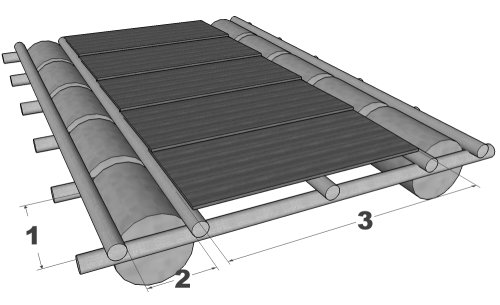
As part of the lead-up to Kontiki, I'll be posting a few tips about building rafts. View all of my raft tips and designs here.
Experience has shown me that the most common mistake in building a raft is in bad measurement- and these are the 3 'show-stopper' measurements- your raft will not be successful if these are wrong.
1: Barrel height. In the kind of raft I have drawn here,you need to make sure there is enough space between lateral poles (poles running left-to-right) on your raft for the barrels to fit in. Remember to allow space for lashings as well - make sure the front-to-back space between lateral poles is the height of the barrel plus the parts of the two square lashings in front of and behind it.
 2: Space for barrel. THIS IS NOT THE BARREL WIDTH. If it is , your barrels will pop through the top of the raft. As a general rule, the widest you would make this with steel drums is to have a point where the top of the barrel is level with the top of the two poles that it is supporting it, like the drawing on the left. When using plastic drums, this space must be much narrower (I have seen plastic barrels pop through surprisingly narrow gaps on more than one occasion). You also don't want this much narrower then around 30cm/12 inches- too narrow and the barrels tend to slip sideways, regardless of how tightly they are tied in. Obviously, when using a technique like Camel, this dimension does not exist (but in Camel the idea of rope tension is important- the binding ropes circling the two barrels need to be slightly loose).
2: Space for barrel. THIS IS NOT THE BARREL WIDTH. If it is , your barrels will pop through the top of the raft. As a general rule, the widest you would make this with steel drums is to have a point where the top of the barrel is level with the top of the two poles that it is supporting it, like the drawing on the left. When using plastic drums, this space must be much narrower (I have seen plastic barrels pop through surprisingly narrow gaps on more than one occasion). You also don't want this much narrower then around 30cm/12 inches- too narrow and the barrels tend to slip sideways, regardless of how tightly they are tied in. Obviously, when using a technique like Camel, this dimension does not exist (but in Camel the idea of rope tension is important- the binding ropes circling the two barrels need to be slightly loose).3: Distance between decking supports. Another relatively simple measurement, but one that is easily forgotten when laying a raft out. Whether you are using plywood, cargo pallets, planks, or poles for your deck, make sure that your decking is supported properly and doesn't fall short of the supports on one side.
Over the next couple of days, I'll put up some tips about moving your raft on the water, placing anchors and anything else I get requests for.

2 comments:
In the raft shown, what was the support material? How much weight were you able to safely load on the raft? Is there a formula?
Hi Jeff.
If by support material you mean the decking, it is 1/2 inch marine ply (commercial ply or shutterboard is much cheaper but less durable). The poles used are 5 inch peeled gumpoles- I'm not sure what your local equivalent would be. In terms of safe loading for a raft, we typically work to around person + kit per barrel- approximately 100kg or 200lb of load per barrel as a maximum.
Post a Comment